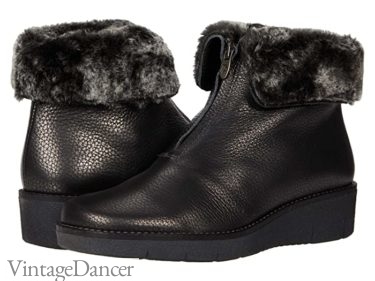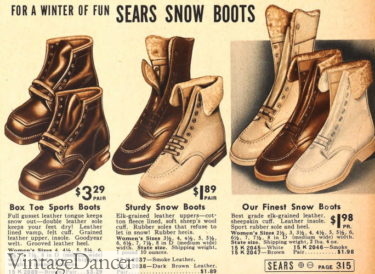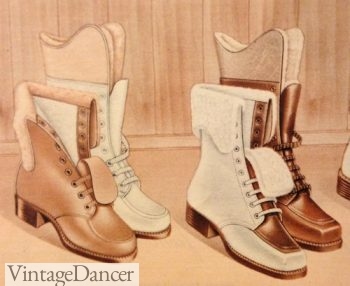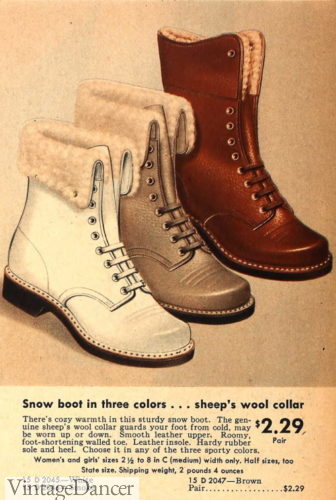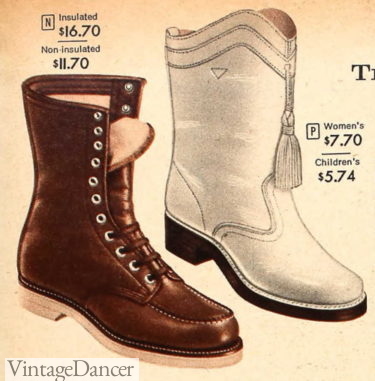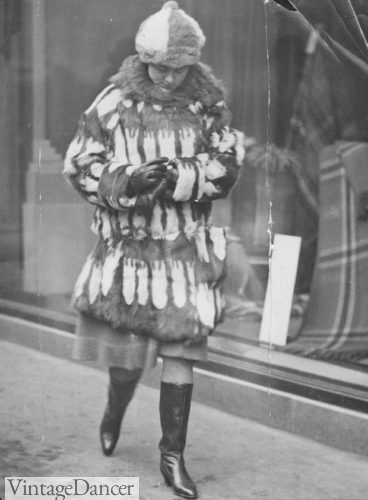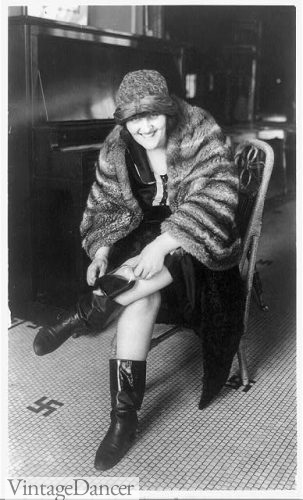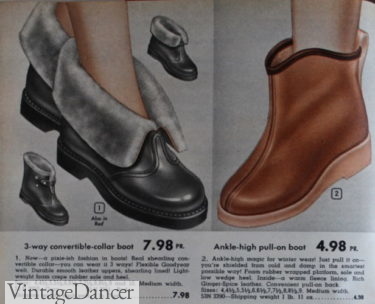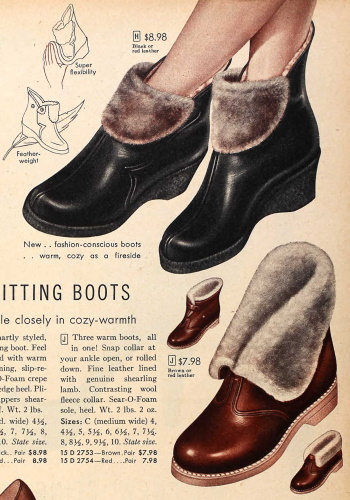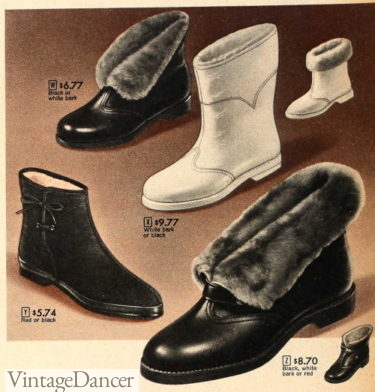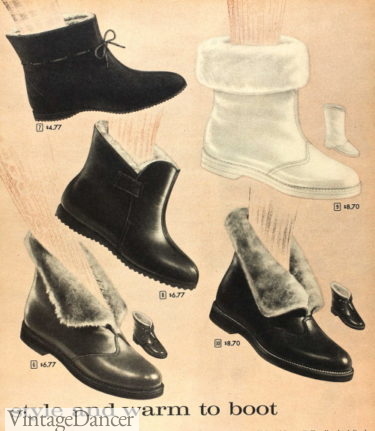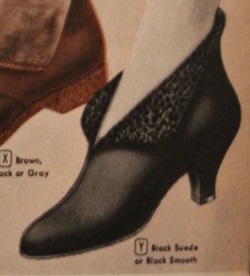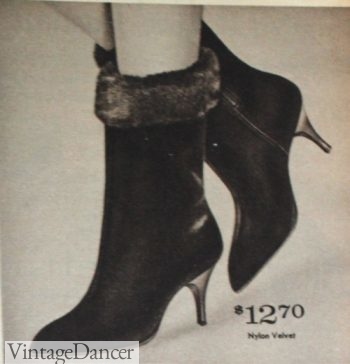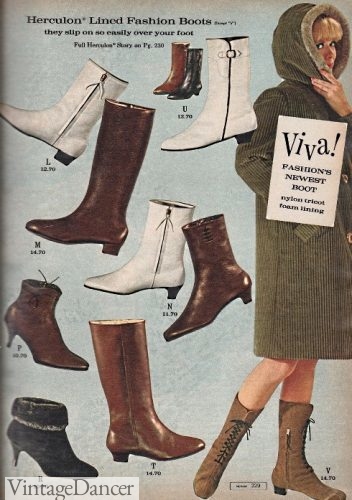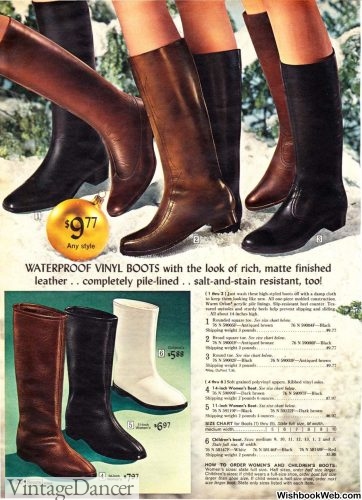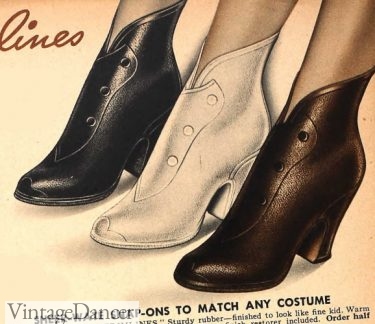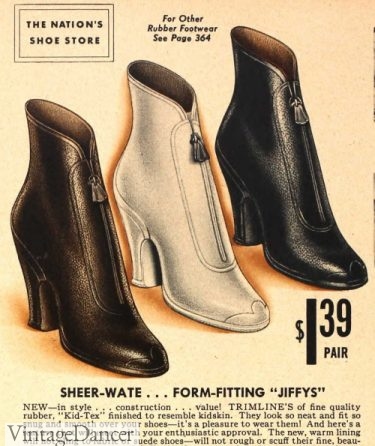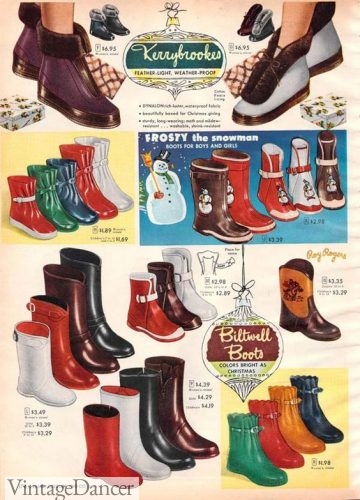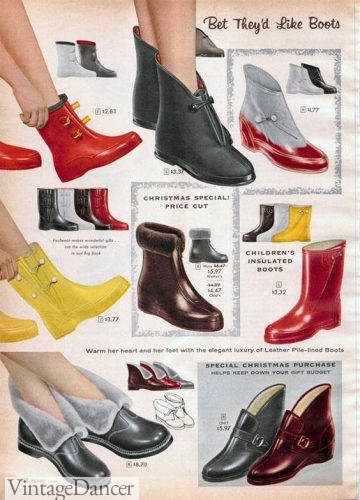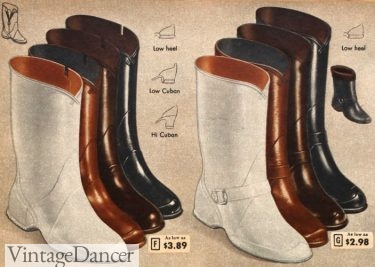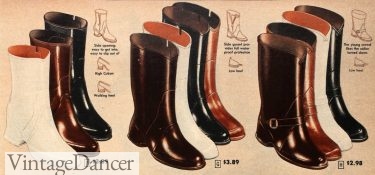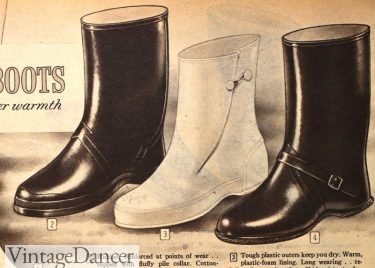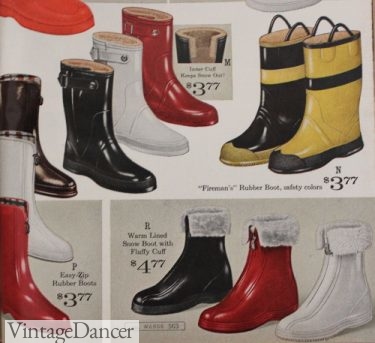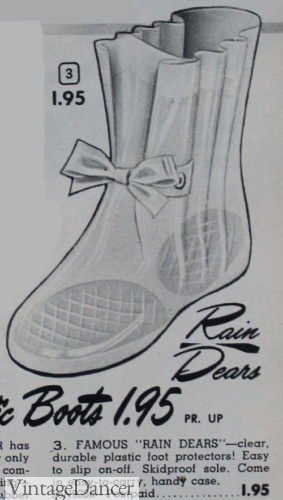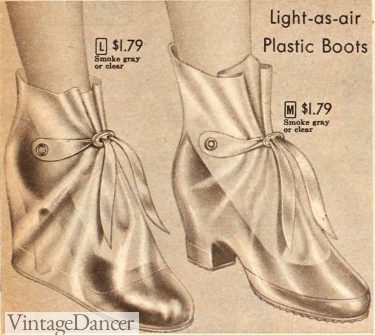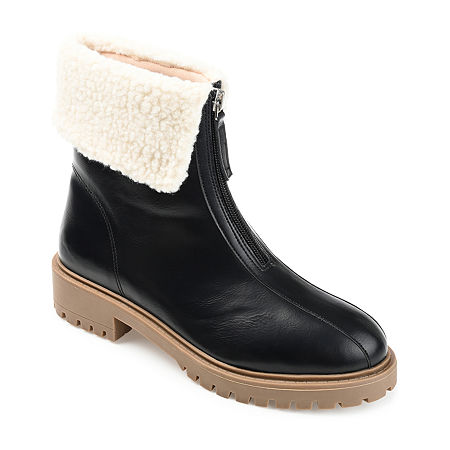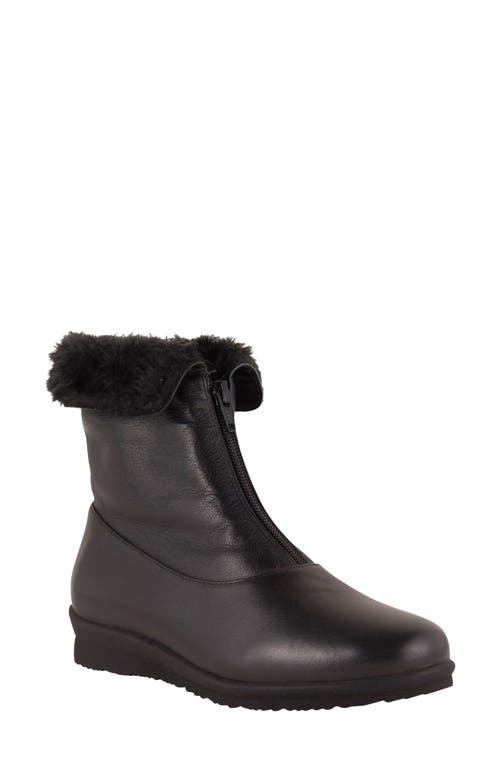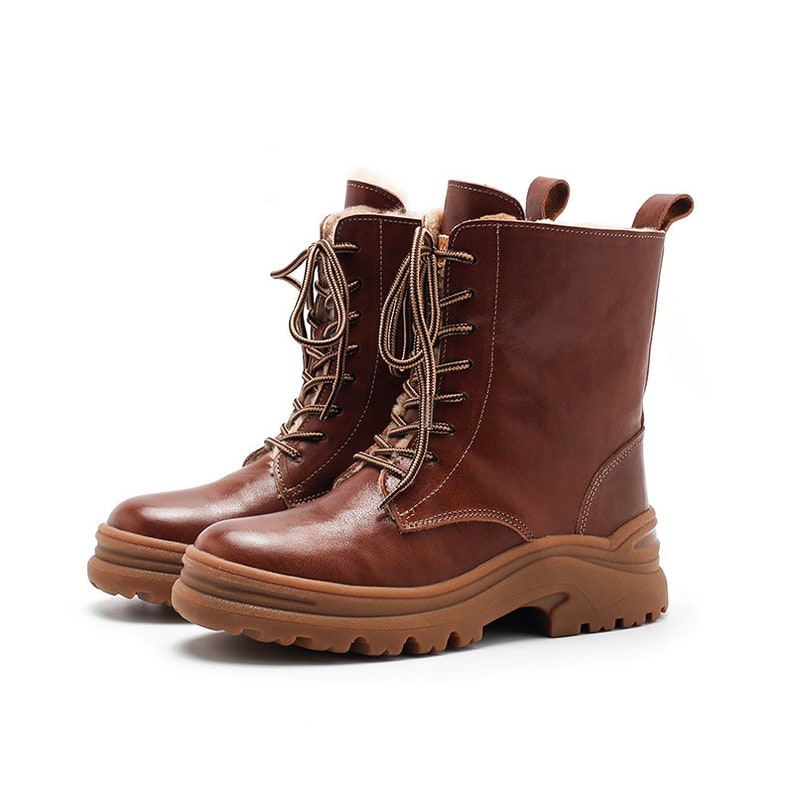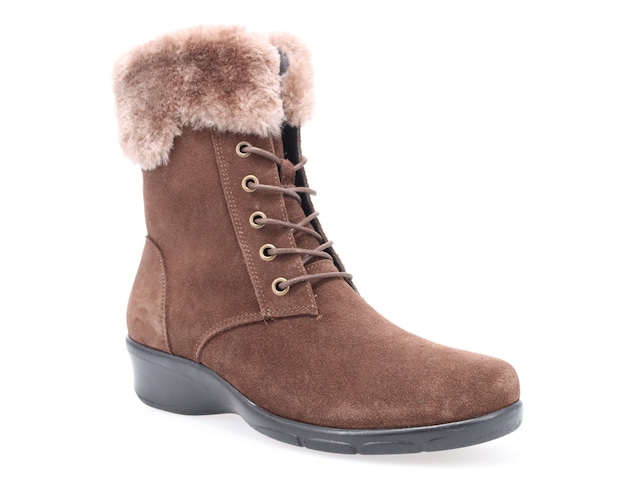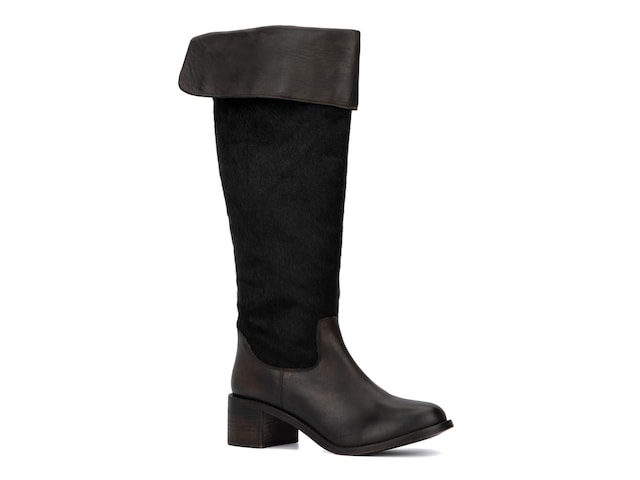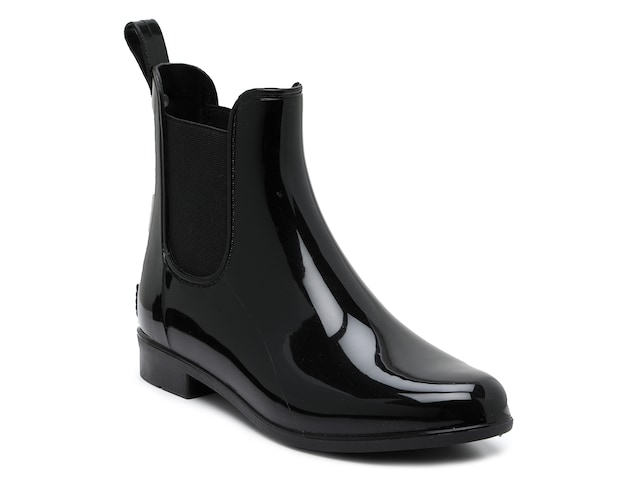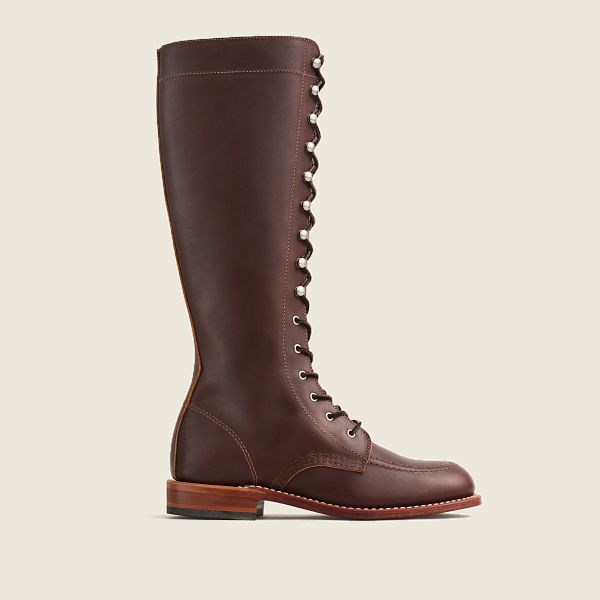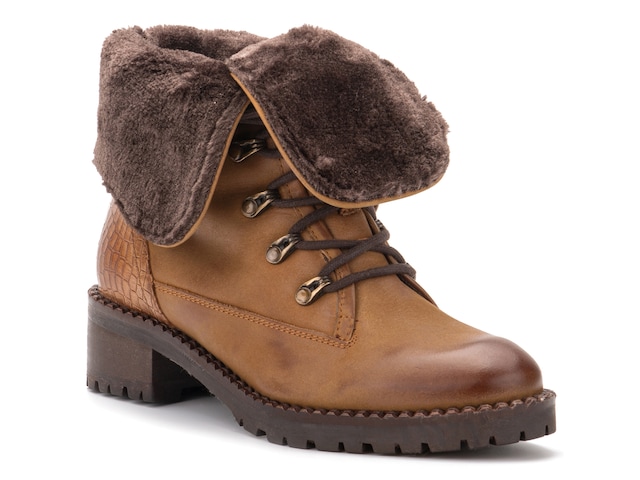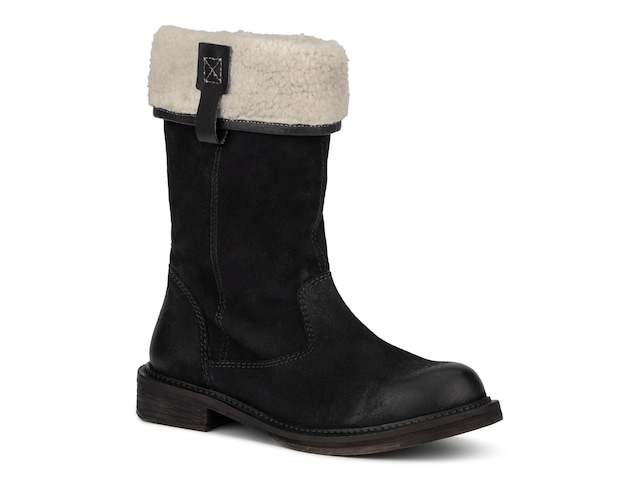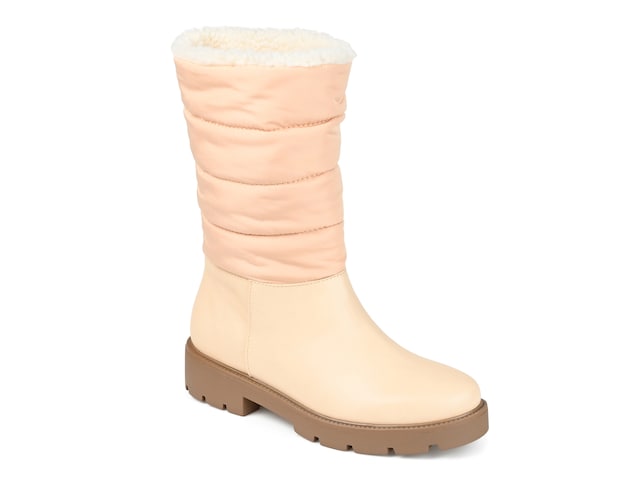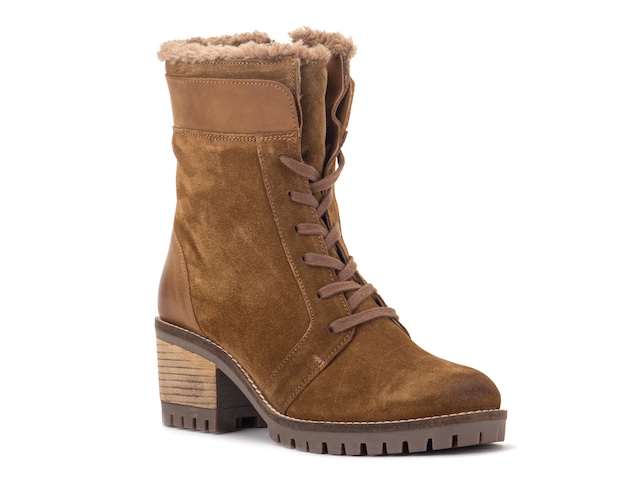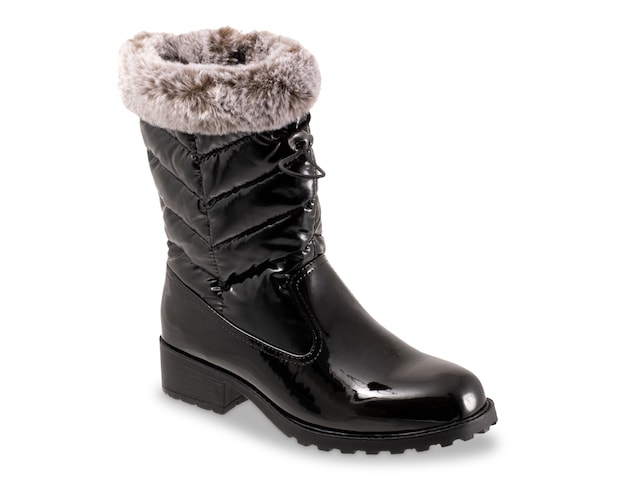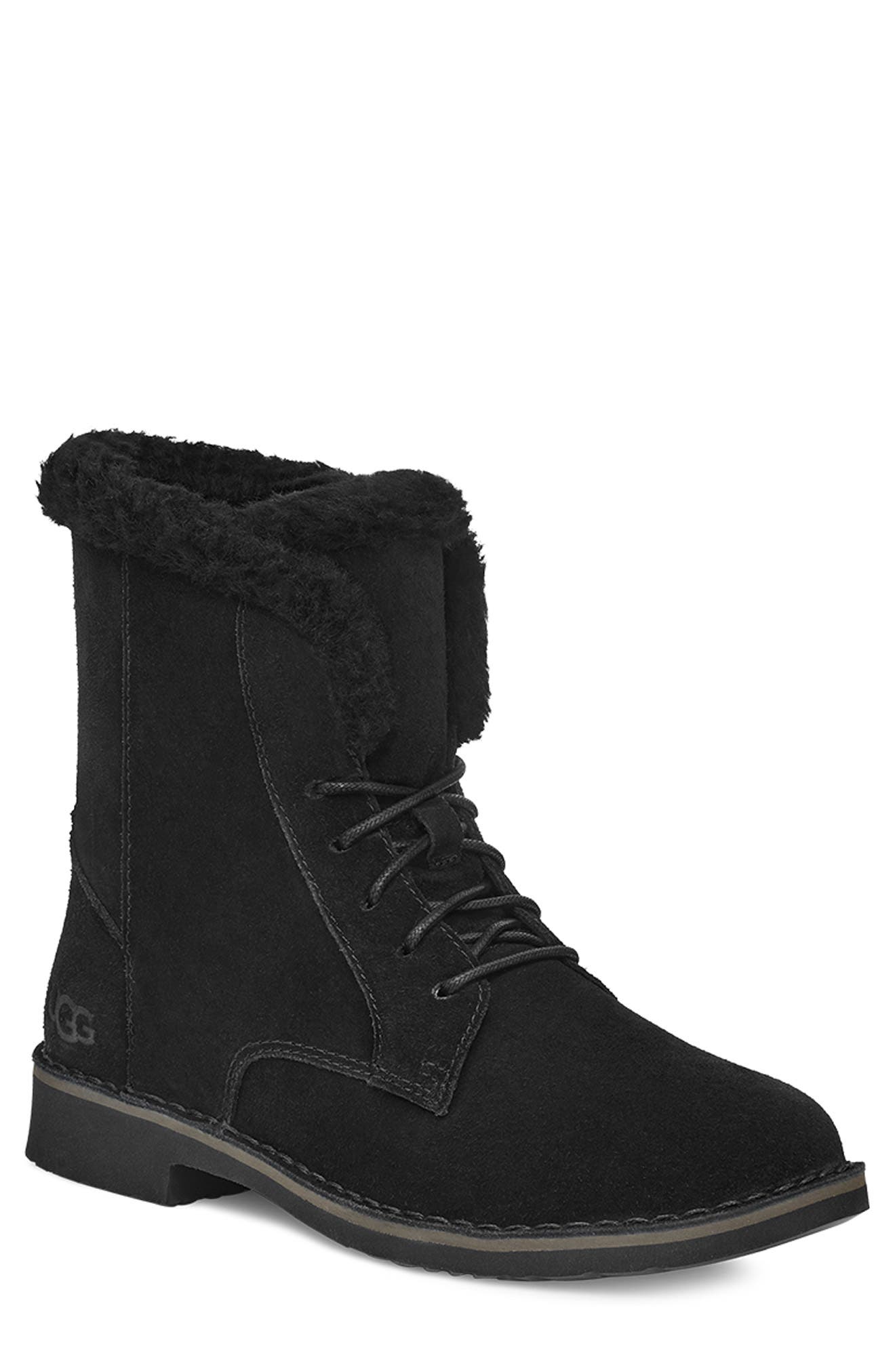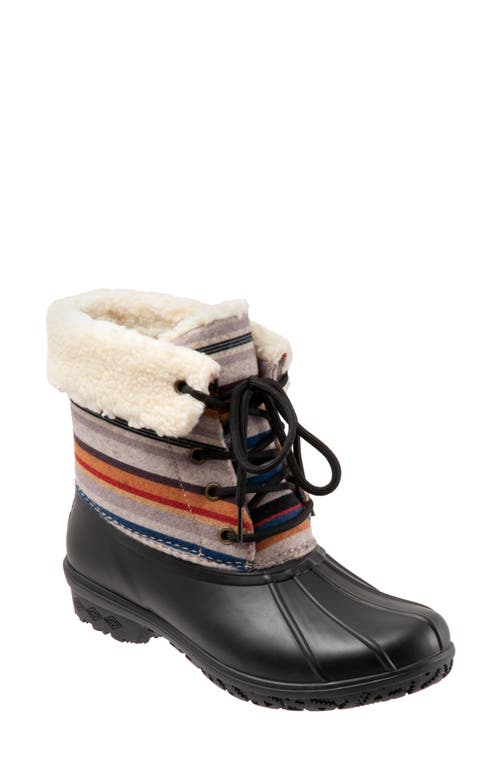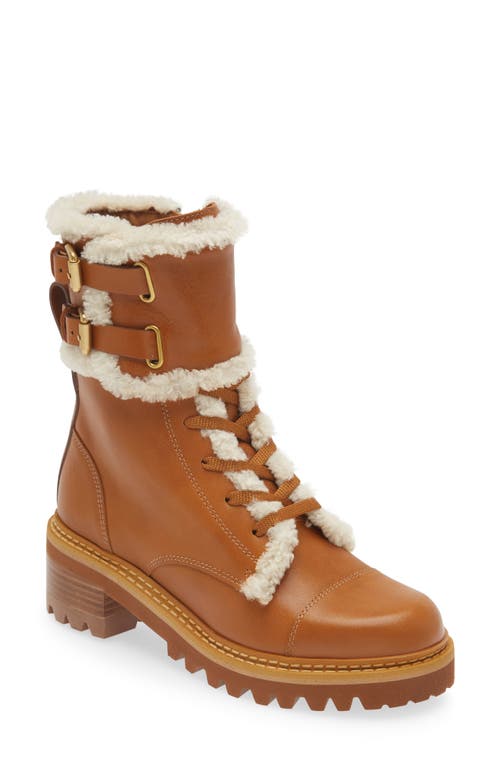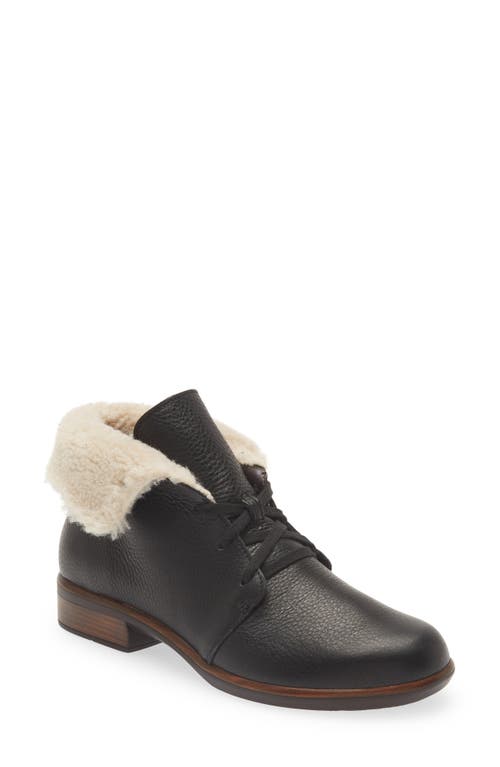Knee deep in snow? Sloshing through the mud? Dancing around rain puddle? When mother nature gets wet, what in the world is a vintage loving gal to wear? This is a BIG question asked every winter. Did women wear vintage boots with dresses? How can I keep my shoes clean and dry when the weather is bad? What snow boots will still look vintage with my pinup outfits?
Skip the history and start shopping for vintage style winter boots here.
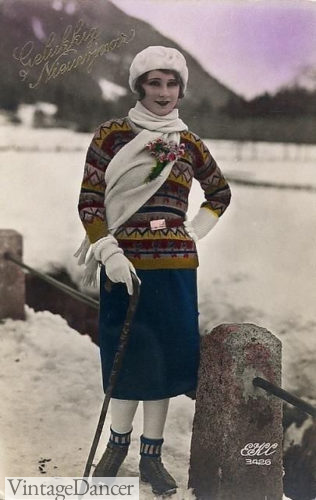
1920 hat, scarf, fair isle sweater, wool skirt, stockings and boots
Turning to the history of boot styles of the 1900s to 1960s we can see that yes indeed, boots were worn in winter, BUT the selection was pitiful compared to the wealth of pretty heeled shoes. Winter boots were practical, not fashionable. They were worn outside only to get from place to place and were quickly removed once indoors. There is a serious lack of vintage photos of women in boots, even ads for winter fashion rarely showed women wearing boots.
Although attempts had been made to make boots fashionable throughout the decades, it wasn’t until the 1960s that designers finally succeeded. Up to that point, winter boots came in a few basic styles: leather lace-up boots, rubber rain boots or shoes, rain covers, and fur-lined booties. I would also add in sport boots to the mix, even though they were not exclusively designed for winter.
Each decade made minor adjustments to the winter boot design and give us hints of what to look for in our quest for the perfect vintage winter boot.
Vintage Fur Boots
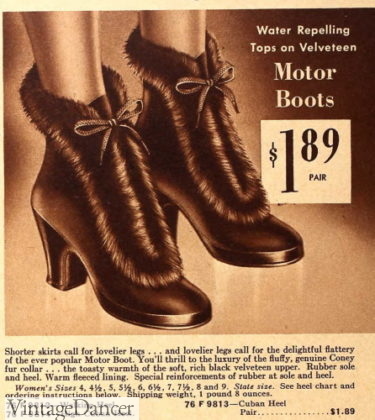
1940 velvet “motor” boots
The most iconic of women’s winter boots are fur lined carriage boots, also called motor boots when cars replaced horse and buggy. Carriage boots that were traditionally a velvet body and lined with quilted silk or fleece and trimmed with fuzzy rabbit fur or faux fur. The fur spilled over the edges and down the length o f the foot, secured with a single lace bow tie.
The carriage boot had been popular for winter travel since the 1860s. They disappeared for a few decades only to appear again in the late 1930s. When salt was used to melt icy walkways in the 1940s, rubber sole boots replaced fabric soles entirely. They were almost always sold in black with black or grey fur. Brown was a less common color.
There were two sole designs for carriage boots as a well as most other snow boots. The flat sole boot and the heeled boot. Flat soles looked like wedge heels while the heeled boot had a center cut out for high or low cuban heeled shoes that slipped into the boot. These “overshoes” meant women could keep their heels on with a quick slip out of them once they reached their indoor destination.
Similar booties were designed for the bare foot, not as overshoes. They required women to carry a pair of heels with them to change into.
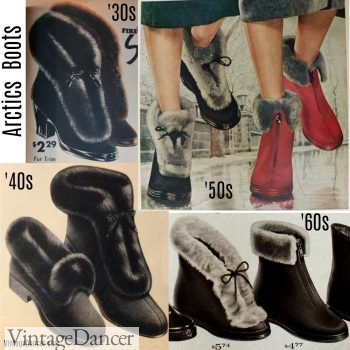
Vintage Arctics Boots inspired by Carriage Boots
Carriage boots were the prettiest of winter boots. Needless to say, they were heavily used by North American women in the 1920s, 1930s, 1940s, 1950s, and 1960s.
The carriage boot came with a zipper option with fur cuff after the late 1920s, however the zipper was prone to freezing in the snow. They were also not watertight. Many women in the 1940s onward put their feet into plastic bread bags before slipping into boots, just to keep dry. Colors were more varied with black, grey, white, red bodies and black, brown or grey fur cuffs. The cuff could be flipped up to keep more warmth around the leg.
Today some reproduction brands try to re-make the cute carriage boots in the winter seasons. Most are not very warm. Mainstream snow shoe brands sometimes have a zip up styles with a wedge/flat sole. These are usually the best for real winter-wear.
Lace Up Boots – Granny Boots
All leather lace-up boots that had been the dominant footwear style for over a century were gradually reduced to winter wear or sportswear only, but the style did not die out. Victorian style lace-up boots, often called granny boots, have appeared in stores and catalogs from the 1920s to now. Winter varieties came lined in shearling wool starting in the late 1920s. Subtle changes to the toe shape, heel type and shaft height happened over the decades but the overall look remained the same. They were favored by older women who grew up wearing the styles.
Granny boots experienced major revivals every 10-20 years but never left fashion entirely. The 1970s and 1990s saw recent revivals. Conveniently, they are back in fashion this year. Yippie!
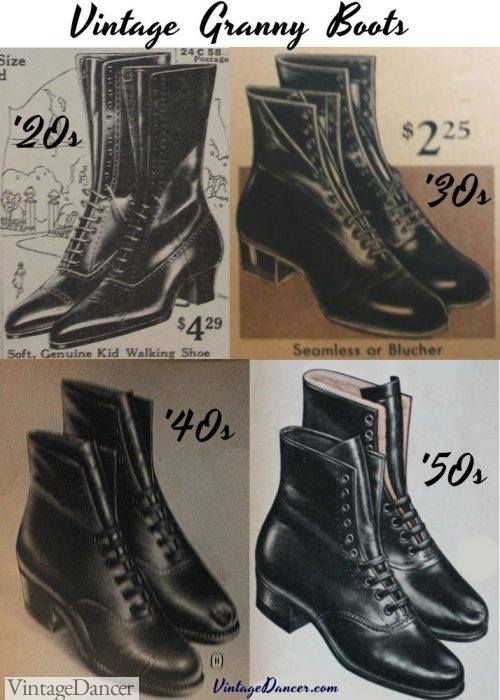
Vintage Lace-up granny boots from the 1920s, 1930s, 1940s and 1950s
In the late 1930s the felt body and rubber sole lace up boot became popular again when shortages of leather happened during war time. Felted wool was very warm but not water proof for long. They also resisted slipping on icy surfaces. They were popular up North in Canada and across northern Europe. Felted boots could come with a felt sole or a leather sole and toe depending on what weather conditionals called for. Some women wore felt sole boots inside the house too- as house slippers.
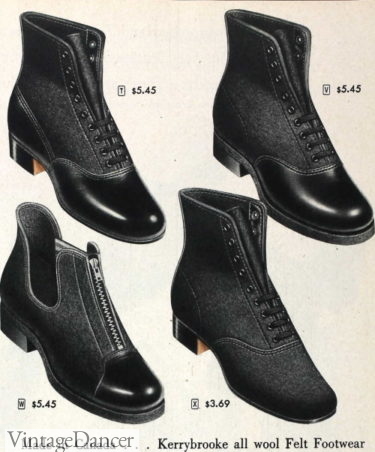
1946 women’s felt boots with rubber soles- both lace up a elastic side panels gusset boots
Vintage Snow Boots
In the late 1930s, women’s winter boots were taking style lines from men’s and women’s outdoor work boots. A very tick and sturdy sole with a moccasin toe, heavy laces and warm lining made them the most practical boot for heavy mud and snow. They were popular with skiers too.
Ladies’ snow boots were usually lined with a fur, shearling, or soft cloth with a collar that could fold up for higher coverage. White, tan, and brown offered more choices than men’s snow boots.
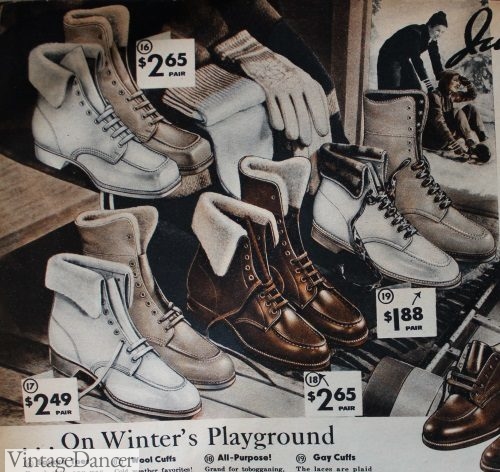
1938 snow boots
The 1940s and 1950s continued to wear the ’30s style snowboot. Two-tone colors were popular in the early ’40s, as well as some buckles at the top instead of only laces. The 1940s blended work and play boots together for a practical, durable shoe. The 1950s and 1960s continued to use lace-up snow boots for sport sports and extreme weather but was less common for everyday wear. They would come back again in the 1970s.
- 1938 snow boots
- 1940s snow boots with two top buckles (L) and Royal Vintage repro 1940s “Rosie” boots
- 1942 snow boots
- 1959 snow boot and majorette boot for women and girls
The best brands for vintage snow boots are modern snow boot brands (when they offer simple classic or vintage styles) or industrial workwear boots. Look for leather bodies with a lace up design and a sole that isn’t too chunky (although you may have to accept a modern snow tread.) Lining in wool shearling, fleece or faux fur will provide the most warmth.
Look at Sorel, Keen, UGG, for modern snow boots. Redwing, Doc Martens, and Wolverine for workwear lace up boots.
Shop vintage retro winter snow and rain boots.
Tall Hiking Boots
The short hemline was first used in women’s bicycle costumes around 1890. To cover her exposed leg, over the calf lace-up boots in black or russet leather with low heels and ridged soles were worn. These vintage boots often had metal hooks on the upper half which allowed the laces to slide and adjust to the movement of flexing calf muscles. These very tall boots were adapted to other outdoor activities such as hiking, ranching, and riding.
Some version of these very tall outdoors boots continued to be made for women until the 1940s. Winter versions were lined in fur or wool and paired with tall boot socks or wool felt inserts. They were a favorite boots style for working women and safari explorers such as Osa Johnson (video, 15 min).
See more hiking/camping photos and boots.
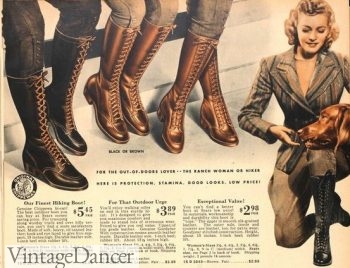
1930s “For the out-of-doors lover. The Ranch woman or hiker.”
Tall hiking boots are incredibly difficult to find with front lacing. I few pop up every year, usually in synthetic leathers, or you will need to have them custom made. Frye boots sometimes have a gorgeous tall leather boot but it sell out very quickly. Redwing Gloria is another excellent boot in the $500+ range.
Back lacing boots are more common now but not accurate to the early and mid-century vintage decades.
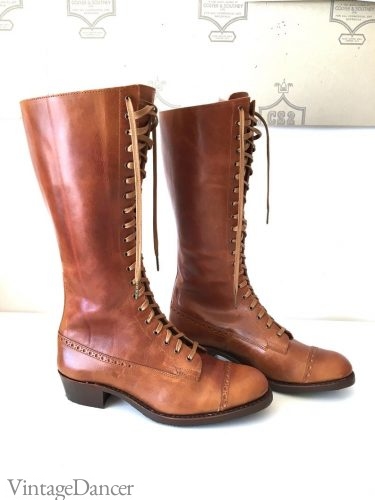
Custom made tall lace up boots by JoBearBoots on Etsy
The riding boot was designed for horseback riding with jodphurs, but some women wore them as hiking and general winter boots too. The buckle across the foot gave it a nod to men’s engineer boots with the side laces or top buckle nodding to traditional riding boots.
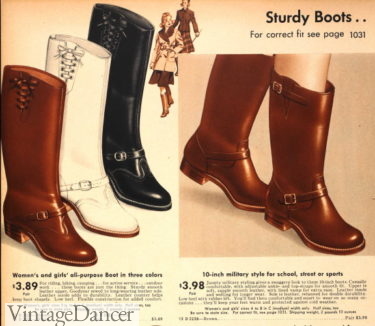
1942 pull on riding inspired boots and engineer style boots
Pull on Boots
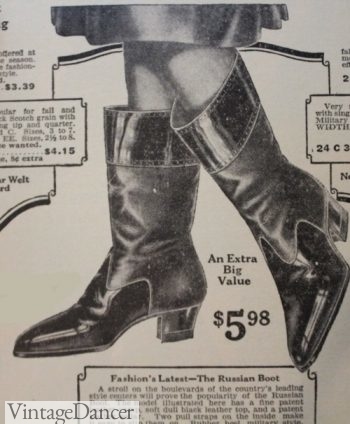
1920s Russian boots- Patent leather collar and vamp with leather body.
In 1921, a fashion boot was introduced called the Russian boot. It was a mid-calf to knee-high pull on boot, with a straight shaft, leather outside, and a 1-2″ Louis or Cuban heel. It fit loose enough over the calf that some bunching around the ankle was expected. Indeed, it was this looseness and flexibility that made them more comfortable than most lace-up leather boots.
The Russian Boot was not worn for fashion, except by the very fashion forward rich and famous. It had a reputation of being worn by women who frequented speakeasies and other underground establishments. Hiding a flask at the top of the boot gave new meaning to the term “bootlegger.”
- 1925 fur winter coat and Russian boots
- 1922, hiding a flask in Russian boots
For the typical woman, Russian boots made feet look large under short dresses. Poor quality materials also made them impractical as weatherproof shoes. Unlike other fashion boots, it did remain a common women’s boot style for most of the ’20s. The later years preferred a taller boot that pulled on or zipped up. They would have been a forgotten boot style if it were not for the late 1950s and 1960s revival of them. Learn more on the Wiki.
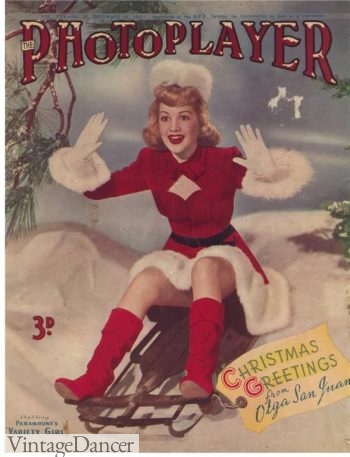
Olga San Juan models red Russian boots in 1947. A bit early for the revival. Perhaps they were only made for costumes.
The pull on chelsea boot or ankle bootie was a constant style throughout the century. With elastic side panels it was easy to slip on and of. I have not seen example of Chelsea boots being worn out in the rain or snow or “in town” so I suspect it was relegated to home and garden use only. (Picture in the felt boot image under granny boots.)
The pull on majorette boot was a fun western inspired boot worn mostly by girls and teens, although sizes were offered for women. They came in white or brown with a tassel hanging from the center shaft. I wouldn’t call them snow boots or even rain boots, but they were fine for cold winter use.
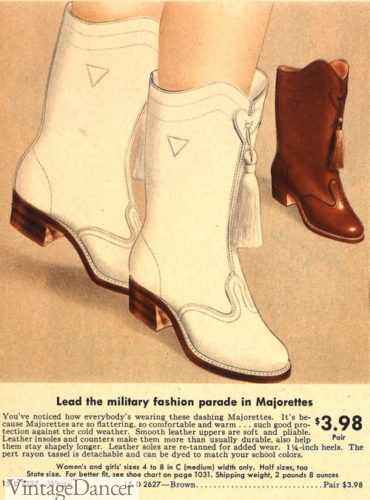
1942 majorette boots
Step-in Winter Boots
Pull on boots or step-in boots began to replace lace-up snow boots in the 1950s. When lined in faux fur and the top folded down into a large cuff, they looked similar to zip up snow boots but without the hassle of frozen zippers and wet feet. Black became the primary color once again with brown and white also options.
- 1953 step-in booties
- 1955 fold down boots
- 1959 pull on/step in snow boots and booties
- 1960 pull on, fur lined boots and booties
When the stiletto heel pumps became trendy with women in the late 1950s, it introduced a new problem for rubber rain boot makers. The pointy heel poked through overshoes, galoshes, and rain covers! The solution was to make pointy heel rubber boots and overshoes. They instantly became more fashionable. Lined with fleece or fur, they were easy to slip into. The top could be folded down for a more fashionable look, or up for more protection.
- 1950s Thin heel booties
- 1960 stiletto heel velvet boots
The 1960s continued the pull on boot style with shorter ankle high booties or very tall over the calf heights in the new shiny vinyl plastics as well as leather and suede (Early UGG’s? yes.) They were also lined in acrylic pile similar to fleece. Soles were usually flat but the dressy skinny stiletto heel was briefly popular in the early years.
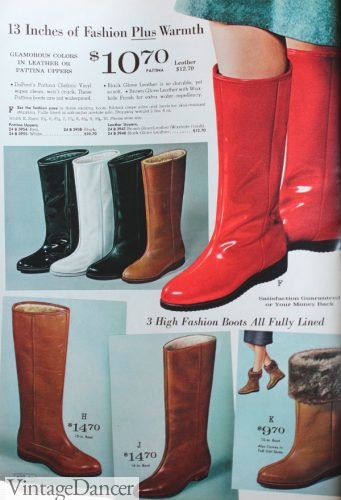
1964 vinyl winter boots with fleece lining
Winter boots crossed into new fashionable footwear in the 60s and 70s. Boots were being worn all year with little change in design from warm to cold seasons. Inside zippers made the over the calf boots much easier to put on. Vinyl made brighter colors trendy such as white, red, and green but brown and black were still the most versatile.
- Mid 60s low heel boots and booties for winter
- 1968 tall leather boots
Rain Boots, Galoshes
One theory for how the 1920s “flapper” got her name is by the boots she wore. Rubber galoshes with buckles left open created a flap, flap, flap sound. Teens never buckled them — it was one of the first style statements the new youth-driven society established.
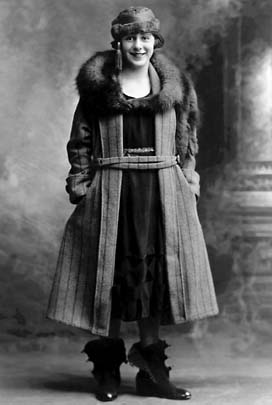
1922, a flapper wearing buckle galoshes worn open
Galoshes were usually overshoes, designed to fit over heels or Oxfords. They could be all rubber or have a rubber foot with a jersey or wool felt body and a light lining. Calf heights came in short ankle or mid-calf. By the end of the decade, snaps replaced big buckles and zippers appeared on the fronts of some models. However, some all rubber galoshes were still being made through the 1960s.
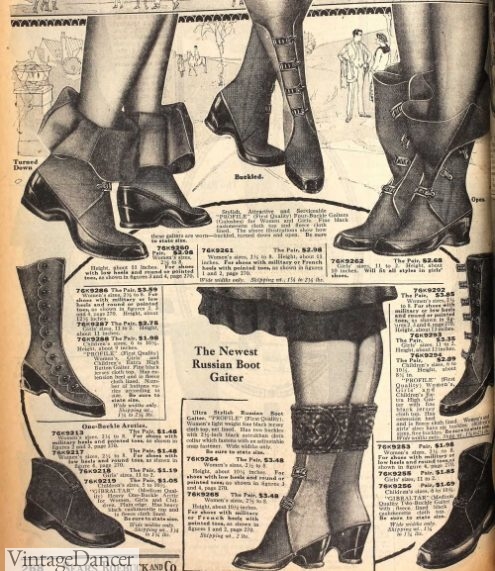
1922 galoshes/ attics rain and snow boots
The late 1920s saw a new rubber overboot, shaped to the foot and ankle made of water resistant rubberized cloth or a tight wool tweed/silk/velvet blend for light weather. It quickly replaced heavy rubber galoshes for dressy outfits. These new rain boots came in various colors, and had wool or rayon jersey uppers in a fun gingham or houndstooth weaves. As rain boots, they also shortened down to ankle height with two heel heights for moderate and heavy snow. The new streamlined look with crossover buttons, scalloped edges was “Art Deco” inspired, making them more fashionable than any rain boot up to that point.
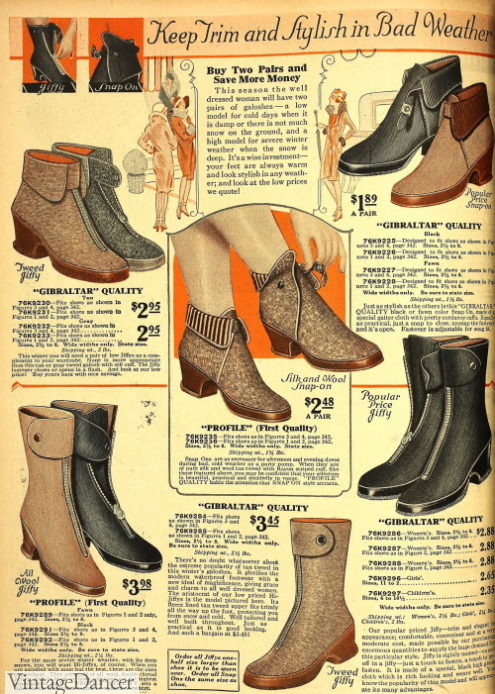
1927 rain boots
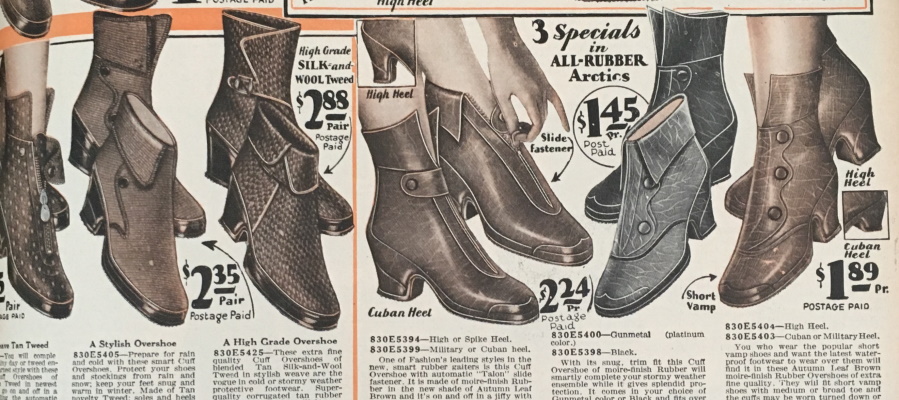
1930 fabric and rubber mixed rain boots
The 1930s expanded on the rain boot but raised the coverage back up a few inches. They also ditched the fabric body for the more practical all rubber with thin cloth lining for easily sliding in heels. The wrap over snap-on buckle was uniquely stylish as well as the two snap flap with scallop edge (some had a zipper under the flap.) The ever classic front zip boot was the least fashionable but most common.
Some non-overshoes had fur or sheering lining. White rubber boots were the new thing of the 1930s. They looked fresh and more feminine compared to the standard black and brown vintage boots.
- 1938 snap-on scallop edge rain rubber boots
- 1938 zip front rubber rain boots
The 1950s saw the loop and button replace the snap over styles. Also new colors – grey, tan, red, and some fabrics like tweed that looked very similar to the early 30s styles. Nylon was the newest and lightest fabric rain bootie that was water resistant enough for light showers. Plastic replaced rubber for less expensive and lighter weight rain boots in the late 50s.
- 1952 rubber rain boots
- 1950s rain boots and snow boots
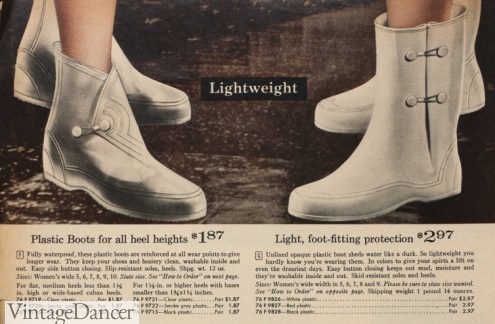
1959 white plastic rain boots
The 1940s also saw the Western boot become common in the spring/summer. They could also be worn in the rain. They gave birth to the plain tall rubber rain boot with or without an engineer strap and buckle. What you imagine as pull on rain boots or Wellingtons (Wellies) today became popular in the 1940s and continued to this day. Initially they were favored by men and children, but when offered in more colors (clear, white, red), women began to wear them and simply carried their heels in a large purse instead.boots
- 1948 rain boots
- 1949 rain boots
- 1961 rain boots
- 1964 colorful rain boots including pull-loops “fireman” rain boots
Rain Shoes, 1920s-1960s
Rain shoes were another classic wet weather option. They were not boots. They were simple black rubber slip-on shoes worn over heels or by themselves. They were often worn over gaiters in the teens and ’20s. These rain shoes remaining unchanged for most of the century. The shapes mimicked pumps of the day, exposing the ankle in the ’30s while remaining modest. Higher sides and a thicker sole were introduced in the ’40s, but became thinner in the 1950s and 1960s.
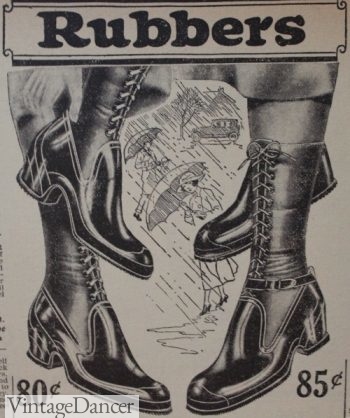
1920s rubber slip on shoes worn over gaiters

1938 rain shoes
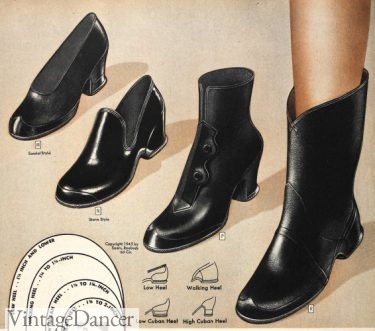
1945 rain shoes and boots
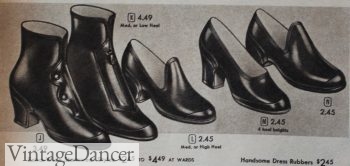
1964 rain shoes and boots
Rain Covers
Changing shoes or wearing heavy overshoes was getting old by the 1950s. Women who lived in milder but wet climates discovered rain covers. Essentially, they were plastic shoe bags with a non-slip rubber sole and a single button, bow or loop to keep them on. Most rain covers came in clear or black plastic.
- 1953 clear rain cover booties with bow
- 1955 clear rain cover shoes
Duck Boots
Rubber foot and leather/cloth body lace up boots are vintage outdoor sport classics for men. They were not offered to women until more recently (1970s?). That doesn’t mean women didn’t wear men’s duck boots, especially for wet/muddy conditions. LL Bean was the original creator calling them Maine Hunting Boots or Bean Boots but many more brands jumped on the trend offering a mix of rubber sole colors, tread patterns, leather, canvas or felt uppers.
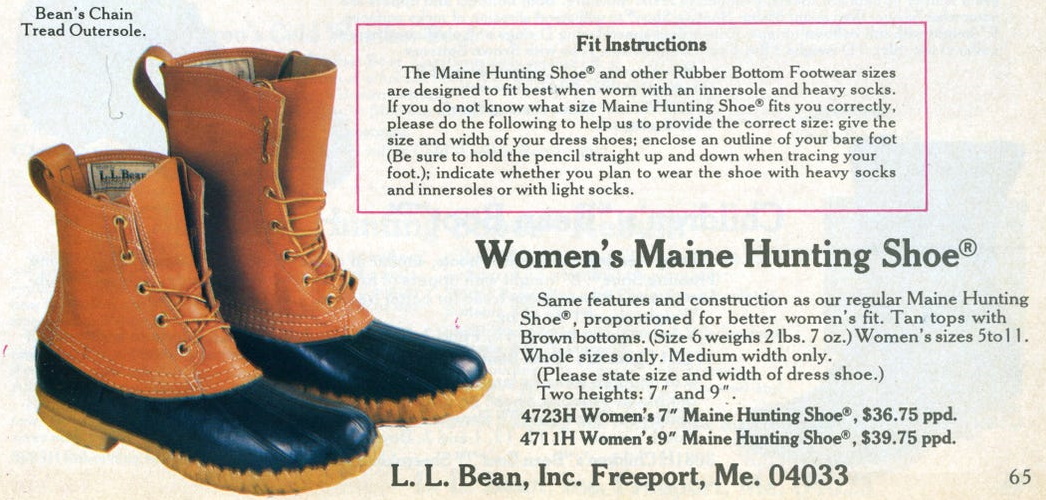
1980 LL Bean “Maine Hunting Boots” aka Duck Boos
Shopping for Vintage Style Winter Boots
If you dress in vintage every day, you know firsthand the horrific task of finding warm, waterproof, yet vintage looking rain and snow boots. Am I right? Every year I search high and low for winter boots to recommend to you. With each season certain styles are revived, while others like fur carriage boots remain elusive. Here is what I look for:
- Granny boots – Lace-up boots with a heel in black or brown are versatile from the 1900s to 1970s. They look great with dresses too. They are probably not great choices for snow unless you find some that are lined (or wear thick tights). For a ’70s look, try some with embroidered designs. Shop here
- Snow Boots – Most modern snow books have very thick tread soles and modern materials, certainly not vintage style. I look for boots with a thin sole, a roll cuff in faux fur or fabric, and a leather body. If you can’t find a fur cuff, you can buy them separately or wear fur cuff socks.
- Rain Boots – Classic, simple, slip-on rain boots are a good choice for the ’50s and ’60s. They may not look very vintage, but they are accurate.
- Rain shoes – Rain overshoes are still being made in men’s or unisex sizes. They slip on over your normal shoes. They are not glamorous, but they’re useful and accurate.
- Rain Covers – Don’t forget the simplest idea for protecting your nice vintage heels with plastic rain covers. Cheap and easy and, yes, vintage too. They beat wearing trash bags over your shoes!
- Duck boots for casual/outdoor sport outfits. Some of the newer designs with white canvas would look very pretty with vintage dresses.
